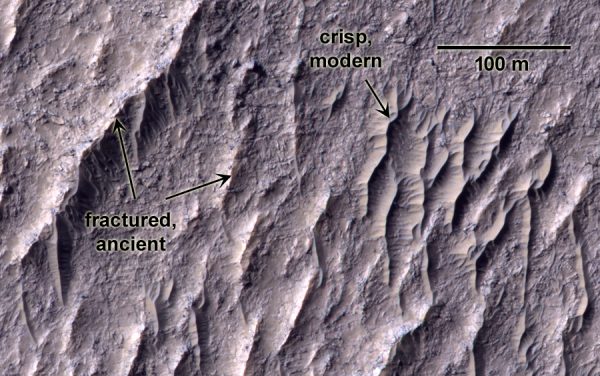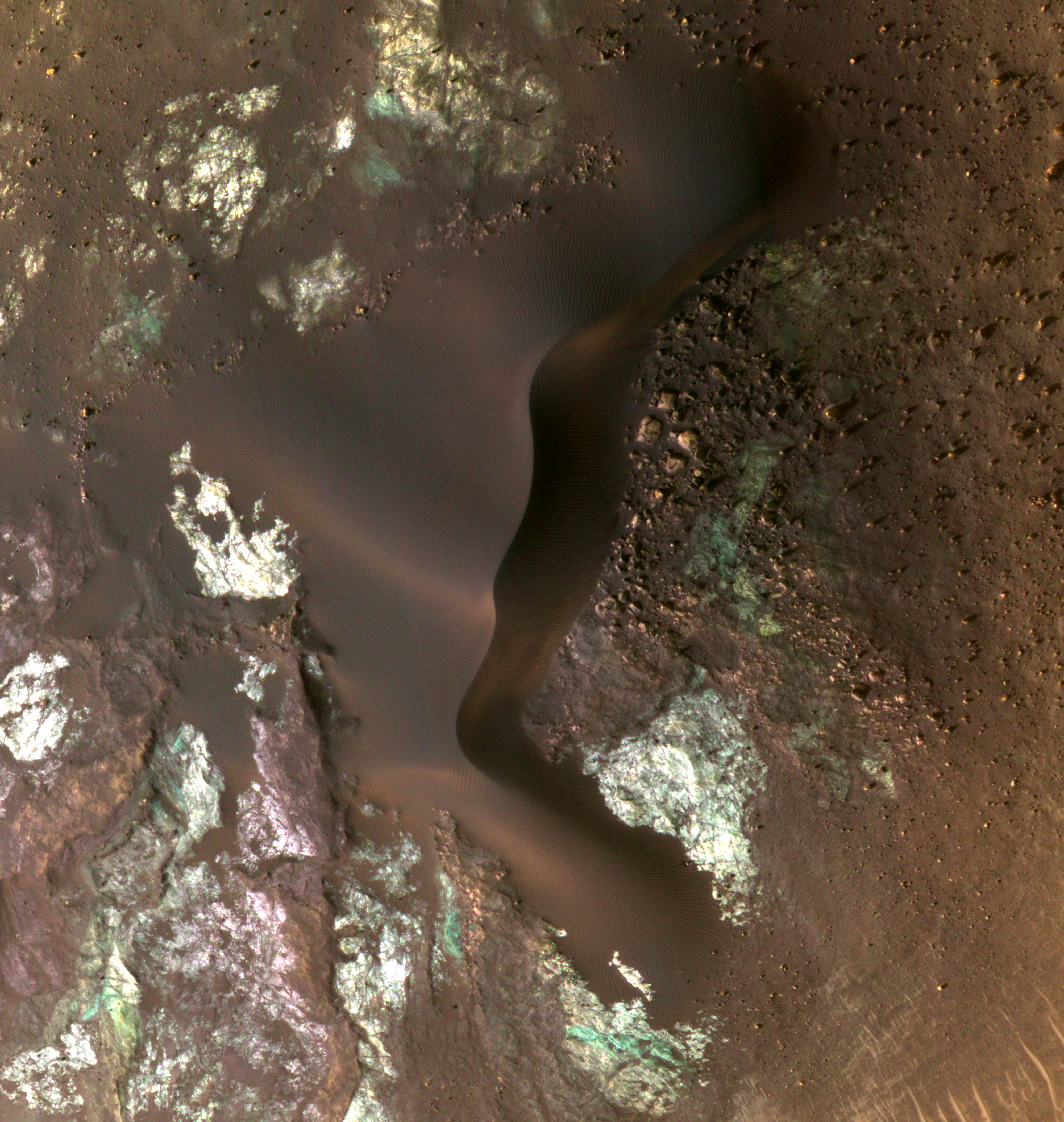Uncategorized
Historical wind and modern wind

May 3, 2022
I don't typically have much time for these posts anymore. The pandemic seems to have changed everything. But sometimes I need to remind myself why I do this for a living. Going to look through Mars' gorgeous scenery is one way I can ground myself (pun not intended). My hope is that by writing these blog posts, I can perhaps share some of that with others.
So let's have another awesome look at Mars, hmm?
HiRISE image ESP_069655_1510. Most of the topography is either old, eroded windblown dune-like features, or modern ones that are quite similar.... read more ❯
Once covered, now revealed

March 29, 2021
Mars is such a fun place. We're finding out that it's got oodles of geologic history. It's got layers deposited by wind and water and lava, altered in place (sometimes many times), then eroded again by wind and water and lava. It's never boring.
My favorite, of course, is the wind. I really like modern dunes that are now crawling across the surface and the wind blows their sand along. But I also like old ones that preserve information about the wind patterns from a long time ago.
This is ESP_068039_1780, a really spectacular HiRISE image that shows a lot... read more ❯
Both wind-carved *and* ancient

1 February, 2021
Are we tired of the pandemic yet? My kids haven't gone to an actual school since last March. Fortunately we're all healthy. I'm able to do most of my work, but it's not easy.
So let's go look at Mars. (I do that when I feel stressed and it usually makes me feel better.) Here's a neat HiRISE image that was recently released (click on any of these images for a closer view):
Lots of (somewhat) straight lines. The orange strip down the center is the part of the camera that collects color information. HiRISE image... read more ❯
Did Proxima Centauri just call to say hello? Not really!

Greetings, Citizens of Earth!
You’ve probably heard about the story, published in The Guardian, a respectable newspaper in the UK, about the potential discovery of an alien signal from the Proxima Centauri system, the star closest to us.
This article, and a companion piece in Scientific American, noted that in April and May 2019, the Parkes telescope in Australia was listening to Proxima b, a red dwarf. This star is known to be active, and this listening was part of a stellar-flare survey.
Shane Smith, a student at Breakthrough Listen, a program privately funded by Yuri Milner to search and find so-called technosignatures,... read more ❯
Dune on a hill

Sept. 2, 2020
Dunes don't usually form on hills. They're made of sand, which is moved by wind (and water and ice) and tends to linger where it gets stuck. You probably know this intimately if you've spent time at a sandy beach. It's true not only on the scale of the threads of a beach towel and in jeans pockets, but also on a larger scale. Dune fields are made of windblown sand that piles up in valleys, or whatever topographic low it's being blown past. The biggest sand sea on Mars, for example, is found at the bottom of... read more ❯
Observe an Occultation by Asteroid Alikoski from San Francisco Bay Area Saturday evening

To all citizen astronomers,
Are you at home like most of us? Good news, you can contribute to astronomy from your backyard on Saturday just after sunset. If you have an eVscope that's super easy. The asteroid (1567) Alikoski will occult a V-11.4 star during up to 2.4 second on Saturday March 29 at 8h18pm (in San Francisco, CA), so just at the beginning of the night . Because of its brightness and the duration of the event, this event is a great opportunity for all of us to learn about Alikoski, a rare-type carbonaceous asteroid from the outer region of the main-belt.... read more ❯
Dome dunes

Feb. 17, 2020
I've been busy but I wanted to squeeze in a quick pretty picture of some Mars dunes. These:
These dark hills of windblown sand are on the small side for Mars. The smallest is ~88 m (288 ft) across (for reference the smaller dunes found on Earth are usually 1/4 this size). What's cool about them is the variation in their slip faces: that steep slope that is just crying out for someone to slide down it (or roll down... read more ❯
Occultation by Nyanza on President Day across the US

Hello,
If you have an eVscope and you want to participate to a scientific campaign on Presidents’ Day, this is something that may interest you. The asteroid 1356 Nyanza will occult a V-12.2 star for up to 6 seconds on February 17 at ~8pm PST and 11pm EST. Yes! This occultation will be visible across the US, from Redding, CA to Philadelphia, PA and Chicago, IL. If a large number of eVscope users observe this event, we will be able to derive the size, shape and eventual existence of moons around the asteroid. So don't wait and take your eVscope out if... read more ❯
Get your Unistellar eVscopes and help observe an exoplanet this weekend!

Dear Unistellar eVscope users,
Want to be involved in something innovative like participating in the very first Unistellar exoplanet detection campaign? Then charge your eVscope and get ready because we need your help this weekend!
My name is Dan Peluso and I am doing my PhD in astrophysics with Franck Marchis (astronomer at the SETI Institute) and as a portion of my research I want to see if it is possible for any astronomy enthusiast around the world to coordinate with planet hunting scientists like us to help contribute to the search for planets around other stars (a.k.a. exoplanets). Exoplanet searches usually... read more ❯
Helping Future NASA Missions: The Case of Orus, Target of the Lucy Mission

A Unistellar team traveled to Oman in early September to observe the occultation of a 11-mag star by the Trojan asteroid Orus. We succeeded in capturing the event with one of our eVscopes, an achievement in and of itself considering the small and uncertain path of this occultation. This is an important breakthrough because this detection will be used for another occultation by Orus again, coming up soon in Australia. On the top of that, this positive detection heralds the arrival of a new tool (the eVscope network) for the study of asteroids, centaurs and trans-Neptunian objects by occultations.
Lucy is... read more ❯